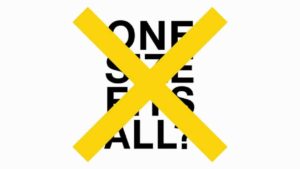“One Size Fits One” Performance Management
 In a prior post, I talked about getting rid of the typical performance management tool where people are rated and ranked. It is so demeaning for many and a time waster for most management staff. It is true that many staff will say they want an evaluation, but what they are really asking for is feedback and recognition. Also, in the humanitarian setting, there are many levels of employees. Some employees at the lowest levels may have trouble reading and writing. This makes the process all the more uncomfortable for them, and meaningless. It takes supervisors a long time to explain what is happening on the evaluation form and what it means. You can’t have a one size fits all system.
In the humanitarian setting, things change all the time. What we planned for last month, or even last week have changed. In an ever changing environment like ours, it makes more sense to just meet with employees frequently, but briefly, to give immediate feedback and to make any course corrections as necessary, in what we call “real time” or “in the moment”?
In a prior post, I talked about getting rid of the typical performance management tool where people are rated and ranked. It is so demeaning for many and a time waster for most management staff. It is true that many staff will say they want an evaluation, but what they are really asking for is feedback and recognition. Also, in the humanitarian setting, there are many levels of employees. Some employees at the lowest levels may have trouble reading and writing. This makes the process all the more uncomfortable for them, and meaningless. It takes supervisors a long time to explain what is happening on the evaluation form and what it means. You can’t have a one size fits all system.
In the humanitarian setting, things change all the time. What we planned for last month, or even last week have changed. In an ever changing environment like ours, it makes more sense to just meet with employees frequently, but briefly, to give immediate feedback and to make any course corrections as necessary, in what we call “real time” or “in the moment”?
Some ideas for implementing a One Size Fits One performance management process:
- What are we going to do? At the beginning of the week, sit down with your staff and discuss what needs to get done during the coming week. What are the important goals for the week? Review priorities. Discuss the resources necessary (people, budget, tools).
- Who is accountable? How will feedback be given during the week? How often? What will happen if something is not achieved?
- What’s happening now? Address any immediate real time concerns you might have about an employee’s or team’s behaviors or actions that seem to be affecting the work or their progress. Don’t let any concerns wait. Address them immediately.
- What can I do for you? Find out what kind of support and assistance that your staff need from you. Ask them what you can do to help.
The One Size Fits One model for performance management focuses on the near future needs of the organization and on the uniqueness and strengths of each individual employee. It can automatically turn a supervisor into a coach and mentor!
In implementing a change like this, what do you see as the benefits? Challenges?